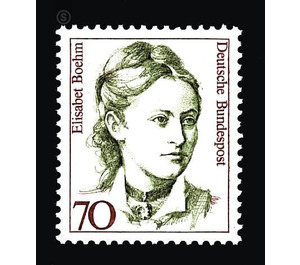Permanent series: Women of German History - Germany / Federal Republic of Germany 1991 - 70 Pfennig
Theme: Economy & Industry
| Country | Germany / Federal Republic of Germany |
| Issue Date | 1991 |
| Face Value | 70.00 |
| Color | brown white |
| Perforation | K 14 |
| Printing Type | 2-color Typography |
| Stamp Type | Postage stamp |
| Item Type | Stamp |
| Chronological Issue Number | 1362 |
| Chronological Chapter | GER-BRD |
| SID | 12348 |
| In 69 Wishlists | |
With more than 550,000 members, organized in more than 11,000 local associations and 17 state associations, the German Landwomenverband is one of the strongest women's organizations in the Federal Republic; the rural women in the five new federal states are currently reorganizing themselves and not included in these figures. This association with the extremely diverse activities of its local associations goes back to the work of a woman who came from the extreme northeast of the former German Reich: Elisabet Boehm. On September 27, 1859, she was born on the domain Rastenburg in East Prussia. As a child sickly, she received hardly any significant training: doctor and parents expected their early death. It came differently; and the lack of education was replaced by many conversations with her very open-minded father, the estate manager and later landowner Hermann Steppuhn. Elisabet read everything she got in her hands; That remained the case when she married Otto Boehm in 1880. She lived with him on Lamgarben Estate near Rastenburg, and although she was sure enough to do, she found her life increasingly unfinished. Above all, she found it a shortcoming that probably the farmers, but not the rural women were professionally organized. She did not leave it at this insight, but founded on February 2, 1898 in Rastenburg the first "Agricultural Housewives Association". The idea ignited: Some time later Elisabets sister Marta founded the second club in - also East Prussian - Bartenstein, more followed, so that as early as 1905 a national association could be constituted, the most important political goal of Elisabet Boehm, the Chamber of Agriculture was affiliated. Until the First World War, the movement first attacked Prussia, but soon also other German lands. In 1916, the provincial associations joined together to form an imperial association, chaired by Elisabet Boehm. By 1932, the number of local associations had grown to well over 2,000. In 1934 ended the work of the Reichsverband; He was integrated into the Reichsnährstand by the National Socialists. In 1948, the successor organization, the German Landwomen Association, was founded in Bad Godesberg. Elisabet Boehm died in 1943. (Text: Professor Dr. Herbert Schwedt, Johannes Gutenberg University Mainz)


